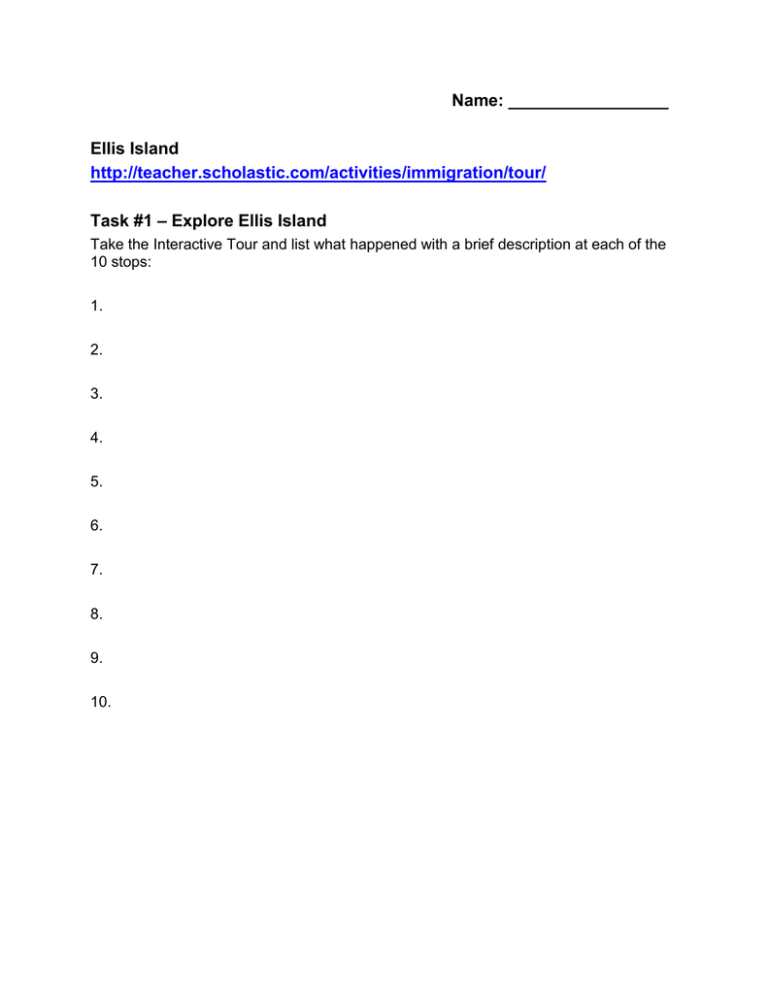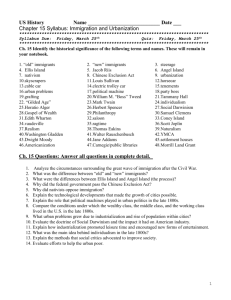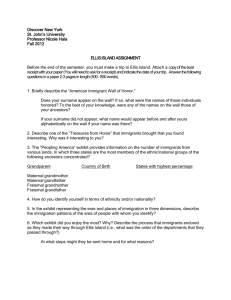Task #1 – Explore Ellis Island
advertisement

Name: _________________ Ellis Island http://teacher.scholastic.com/activities/immigration/tour/ Task #1 – Explore Ellis Island Take the Interactive Tour and list what happened with a brief description at each of the 10 stops: 1. 2. 3. 4. 5. 6. 7. 8. 9. 10. Task #2 – Meet Young Immigrants Choose one of the young immigrants and tell me about their story: Name: _____________________ His/Her Story: Task #3 - Immigration Data Answer these questions: 1. Which 3 decades had the highest immigration numbers? 2. After the 1840’s, which 2 decades had the fewest immigrants? Why might that be the case? 3. By region, list in order from greatest to least where the immigrants came from when they emigrated to the U.S. Virtual Tour video – neat video that might help you understand the first part of the assignment better. Ellis Island Fun Facts Dutch settlers called the island Oyster Island because of the abundance of oyster beds nearby. Oysters were a valuable food source for Native American tribes. The unofficial motto of Ellis Island workers was "keep it moving!" Workers were trying to keep the line moving because the station was overcrowded. The immigration station was designed to process 5,000 people per day. But during the peak immigration period, more than 11,000 immigrants arrived every day. A fire destroyed the main building on Ellis Island in 1897, as well as immigration records kept in the building that dated back to 1855. For just 30 cents, an immigrant could purchase bread, cheese, sausage, and lemonade at the concession stand. After World War I and the Russian Revolution, there was a widespread fear of communism; it was called the "Red Scare". Immigration officials tried to keep out communists, who were also known as "radicals" and "undesirables". First- and second-class passengers were not required to go to Ellis Island for immigration processing. Officials thought that if an immigrant could afford a first- or second-class ticket they probably were not sick or in financial trouble, conditions which could make them a burden on American society. Before 1907, many children made the trip to America alone. Some traveled thousands of miles without a parent or guardian. But after 1907, it was prohibited for anyone under the age of 16 to come through Ellis Island without an adult. The highest number of immigrants came through the Ellis Island immigration station in 1907. In that year 1,004,765 immigrants arrived. More than 29,000 tiles were used in building the Great Hall, the largest room in the main building on Ellis Island. After 1917, the U.S. government required immigrants to be literate; this meant they had to be able to read and write in their native language. Literacy was determined in the Great Hall during the inspection process. Ellis Island was originally 3.3 acres. Over the years, it grew to its current size of 27.5 acres. That’s eight times bigger! How did this happen? Rock and earth taken from massive construction projects, such as the building of New York City’s subway tunnels, was added as landfill around the original island. In 1965, President Lyndon B. Johnson signed a proclamation to make Ellis Island a National Monument. Before Ellis Island opened as the first federal immigration station, immigrants arriving in New York City were processed at Castle Garden, located at the tip of Manhattan. More than 11 million immigrants came through Castle Garden from 1820 to 1892.






